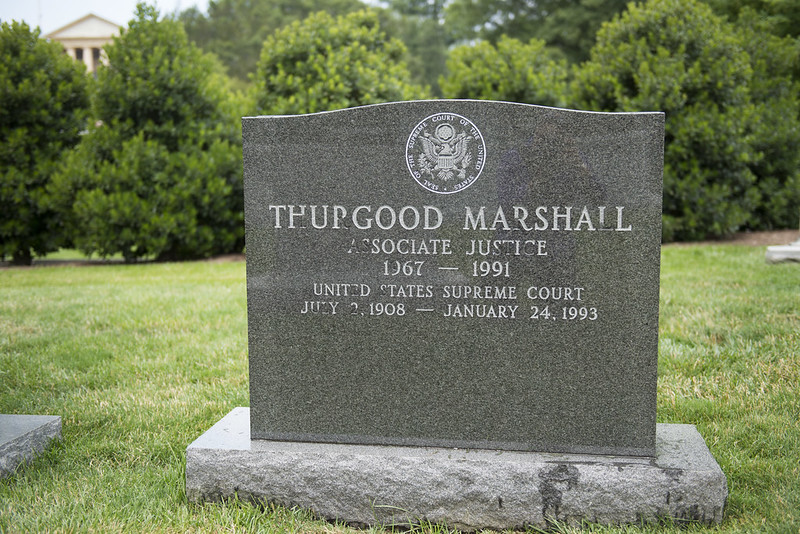Erik Visits an American Grave, Part 158
This is the grave of Thurgood Marshall.
While Marshall is justly famous, his actual life is not so well known so it’s worth spending some time laying this out.
Born in 1908 in Baltimore, Marshall was something of an indifferent student through high school and into college at Lincoln University. He did alright, but there wasn’t much that made people think that here was a rising star. He married in 1929, still in college, and began to buckle down. He attended law school at Howard because Maryland’s law school remained segregated. He graduated first in his class in 1933. He initially went into private practice but began doing work for the NAACP in 1934 and this would define his career. In fact, it was his own hobbyhorse that got him on this track–the segregation at the University of Maryland. He represented the group in Murray v. Pearson and won the case because the state did not provide a comparable institution for black law students. By the mid-1930s, the NAACP was having greater success at chipping away at segregation through cases like this which argued that separate but equal had to include an equal. He became the head of the NAACP Legal Defense Fund in 1940, still only 32 years old. He argued 32 civil rights cases before the Supreme Court over the next 20 years, winning 29 of them. This of course culminated in his arguments in Brown v. Board of Education in 1954 that overturned the principle of separate but equal, even if the Warren court fled from enforcing the ruling. But it also included Smith v. Allwright, which eliminated the Texas white primary in 1944, Shelly v. Kraemer that outlawed racially restrictive real estate covenants, and Sweatt v. Painter that integrated the law school at the University of Texas.
Marshall did however have his conservative side. He was not particularly comfortable with grassroots organizing or radicalism. Based upon this and a deep hatred of communism, he developed a good relationship with J. Edgar Hoover, of all people, denouncing more radical civil rights leaders to him, including T.R.M. Howard, who in the 1950s would criticize the FBI for not conducting a serious investigation into the murder of Emmitt Till. Marshall hated Howard for this radicalism and hoped the NAACP and FBI could develop a strong relationship. Marshall also fed Hoover information about people he suspected of being communist. This was wrong-headed, to say the least. Moreover, the FBI kept its own file on Marshall during these years.
Marshall largely kept his distance from the grassroots civil rights movement developing in the 1950s and 1960s, which reflected both the larger NAACP’s discomfort with much of this, as well as the generational divide of an older man in a movement dominated by young people. He had no idea what to do with SNCC, whose direct action tactics made absolutely no sense to him. When the Freedom Riders refused bail, Marshall was utterly exasperated. John Lewis later wrote that Marshall simply didn’t understand their movement and a talk Marshall gave at Fisk shortly after, while Lewis was still a student, made him realize that SNCC was not only a movement against white supremacy, it was also a movement against the established black leadership.
Marshall left the NAACP in 1961 after President Kennedy nominated him for a position on the Second Circuit, despite segregationist senators holding up his nomination as long as possible. He then became Solicitor General in 1965 before Lyndon Johnson nominated him to the Supreme Court in 1967. This came about in part because Marshall and LBJ became personally close, despite Johnson’s love of racist jokes that he told in front of white people. They liked to drink bourbon together and tell long-winded stories. He was confirmed 69-11, making him, of course, the first African-American justice. That said, it was not an easy confirmation because of the white South. Strom Thurmond basically forced Marshall into a literacy test while testifying, asking him to name the members of the congressional committee that created the Fourteenth Amendment, the type of trivia used to make sure blacks could not vote. After this went on for awhile, Ted Kennedy asked Thurmond the same question and of course Strom didn’t know, but that was hardly the point. In fact, the low number of votes at all in Marshall’s confirmation came from Johnson lobbying southerners to just abstain. Marshall asked Hugo Black to swear him in, a noted request for a man who had once been in the Ku Klux Klan but had since more than made up for it through his consistent liberal activism on the Court.
He then went onto to be a leading liberal on the Court during his 24 years there. He and William Brennan formed the left side of the Court, fighting for abortion rights, against the death penalty, and of course for civil rights broadly construed. By many accounts, he disliked his time on the court, particularly as it moved to the right. He seemed to become bitter and disconnected later in his tenure.
Marshall retired in 1991 and George H.W. Bush polluted his legacy by nominating the odious Clarence Thomas to replace him, who of course remains there today. Marshall died in 1993, at the age of 84.
Despite Marshall’s famed status, his politics are so anathema to the Republican Party that when his former clerk Elena Kagan was nominated to the Court in 2010, Republican senators such as Jefferson Beauregard Sessions III tried to attack her by attaching her to his politics. The upshot is that Republicans would not confirm Thurgood Marshall today.
Thurgood Marshall is buried on the confiscated lands of the traitor Lee, Arlington National Cemetery, Arlington, Virginia.




